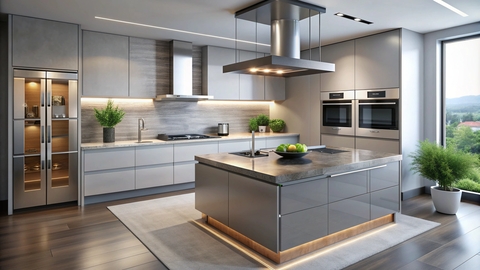Are you tired of your outdated oven holding you back in the kitchen? Or maybe you're building a new home and trying to decide between a freestanding or built-in oven. Choosing the right oven can make all the difference for your cooking experience and the overall look of your kitchen.
To help you make the right choice, we’re exploring the pros and cons of built-in ovens so you can find the oven that suits your needs and style. Get ready to discover the perfect appliance that will take your culinary skills to new heights!
What is the difference between an oven and a built-in oven?
The main difference between a freestanding oven and a built-in oven lies in their installation and appearance:
Freestanding ovens are self-contained units that can be placed anywhere in the kitchen. They often have a hob or cooktop on top. They are typically less expensive and easier to install than built-in models.
Built-in ovens, on the other hand, are designed to be installed into a cabinet or wall, creating a seamless, integrated look in your kitchen. They are usually more expensive but offer a sleek, modern aesthetic.
Another key difference is that built-in ovens are often paired with a separate cooktop, allowing for more flexibility in kitchen layout and design.
What are the disadvantages of a built-in oven?
While built-in ovens offer many benefits, there are a few potential drawbacks to consider:
Cost: Built-in ovens can be more expensive than freestanding models, as they require custom installation and may need additional cabinetry or modifications to fit your kitchen layout.
Limited mobility: Once installed, built-in ovens are not easily movable, so if you plan to rearrange your kitchen in the future, it may be more challenging to relocate the oven.
Accessibility: Depending on the height at which the oven is installed, it may be less accessible for some users, especially if it's placed at eye level or above.
Are built-in ovens a standard size?
Built-in ovens come in a variety of sizes to fit different kitchen layouts and preferences. The most common sizes are:
60 cm (24 inches) wide: This is the standard size for a single built-in oven and can fit most kitchen cabinets.
90 cm (36 inches) wide: Larger kitchens may accommodate a double built-in oven, which provides more cooking space and flexibility.
45 cm (18 inches) wide: Compact built-in ovens are ideal for smaller kitchens or as a secondary oven for additional cooking capacity.
It's important to measure your kitchen cabinet space carefully and consult with the manufacturer to ensure you choose a built-in oven that fits perfectly.
Are built-in ovens worth it?
Built-in ovens can be a worthwhile investment for several reasons:
Improved kitchen aesthetics: By integrating the oven into your cabinetry, you can create a clean, cohesive look that enhances the overall appearance of your kitchen.
Increased functionality: Many built-in ovens, like Beko's feature-rich models, offer advanced features such as steam cooking, pyrolytic self-cleaning, and smart connectivity, making cooking more efficient and enjoyable.
Resale value: A well-designed, high-quality built-in oven can add value to your home and make it more attractive to potential buyers if you decide to sell in the future.
However, the decision ultimately depends on your budget, kitchen layout, and personal preferences. It's essential to weigh the pros and cons to determine if a built-in oven is worth the investment for your specific needs.
Which is better, the freestanding or built-in oven?
The answer to this question hinges on your own personal taste. From a practical perspective, the choice between a freestanding or built-in oven depends on several factors:
Kitchen layout: If you have a smaller kitchen or an open floor plan, a freestanding oven may be more practical as it offers more flexibility in placement. Built-in ovens, on the other hand, work best in kitchens with dedicated cabinet space.
Budget: Freestanding ovens are generally more affordable than built-in models, especially when factoring in the cost of installation and any necessary modifications to your kitchen.
Aesthetic preference: If you prefer a sleek, integrated look, a built-in oven is the way to go. Freestanding ovens can be a good choice if you want a more traditional or eclectic kitchen design.
Ultimately, there is no one-size-fits-all answer, and the best option depends on your specific needs and preferences. Consider your kitchen layout, budget, and desired aesthetic when making your decision.
Spoiled for Choice
The Beko Built-in Oven, model BVM32400A, offers a host of practical features designed to make cooking more efficient and enjoyable.
An 80-litre capacity makes it perfect for preparing large family meals or entertaining guests. The oven's AeroPerfect™ technology ensures even heat distribution, so your dishes are cooked perfectly every time, while the self-cleaning function takes the hassle out of maintenance. The sleek, modern design fits seamlessly into any kitchen, and the easy-to-use touch control panel simplifies the cooking process. Whether you're baking, roasting, or grilling, this oven is a versatile and reliable addition to your culinary toolkit.
Beko Built-in Ovens Are Better
Yes, built-in ovens offer a range of benefits, including improved kitchen aesthetics, increased functionality, and potential resale value. However, they also come with some drawbacks, such as higher costs and limited mobility.
When choosing between a freestanding or built-in oven, carefully consider your kitchen layout, budget, and personal preferences to make the best decision for your home. If you're in the market for a feature-rich built-in oven, be sure to explore Beko's selection of high-quality models to find the perfect fit for your cooking needs.



